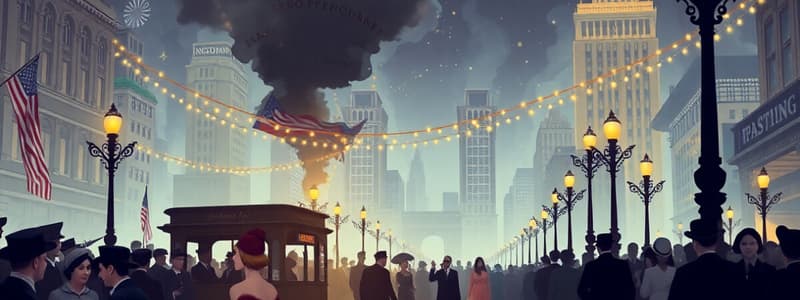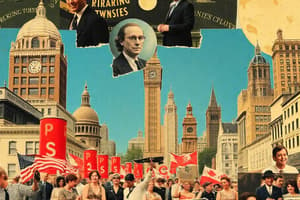Podcast
Questions and Answers
What event is commonly associated with the beginning of the U.S. oil boom?
What event is commonly associated with the beginning of the U.S. oil boom?
- Introduction of automobile manufacturing
- Construction of the Los Angeles Aqueduct
- Discovery of oil at Spindletop (correct)
- The establishment of Ford's assembly line
Which innovation significantly changed the automobile industry in the 1920s?
Which innovation significantly changed the automobile industry in the 1920s?
- The transition to hybrid technology
- The use of assembly line production (correct)
- The development of internal combustion engines
- The introduction of electric cars
How did the growth of cities during the early 20th century impact American life?
How did the growth of cities during the early 20th century impact American life?
- Encouraged isolationism within communities
- Increased reliance on rural resources
- Fostered a new sense of freedom and independence (correct)
- Led to a decline in automobile ownership
What was a major consequence of the construction of the Los Angeles Aqueduct?
What was a major consequence of the construction of the Los Angeles Aqueduct?
Which of these statements reflects the economic condition of America during the Roaring Twenties?
Which of these statements reflects the economic condition of America during the Roaring Twenties?
What phrase encapsulates President Coolidge's view on business in America?
What phrase encapsulates President Coolidge's view on business in America?
During the 1920s, which cultural phenomenon was distinctly significant in American society?
During the 1920s, which cultural phenomenon was distinctly significant in American society?
What was one major social conflict present in American society during the Roaring Twenties?
What was one major social conflict present in American society during the Roaring Twenties?
What was a direct consequence of Prohibition in the United States?
What was a direct consequence of Prohibition in the United States?
Which event highlighted the racial tensions faced by African Americans during the Great Migration?
Which event highlighted the racial tensions faced by African Americans during the Great Migration?
What innovation did Henry Ford introduce to revolutionize transportation in America?
What innovation did Henry Ford introduce to revolutionize transportation in America?
What was one of the economic implications of the discovery of oil at Spindletop?
What was one of the economic implications of the discovery of oil at Spindletop?
What was one significant outcome of William Mulholland's construction of the Los Angeles Aqueduct?
What was one significant outcome of William Mulholland's construction of the Los Angeles Aqueduct?
What phenomenon did the Prohibition era in the U.S. primarily reveal about legislative efforts?
What phenomenon did the Prohibition era in the U.S. primarily reveal about legislative efforts?
How did the automobile revolution impact American society?
How did the automobile revolution impact American society?
What significant economic event occurred at the end of this transformative period in America?
What significant economic event occurred at the end of this transformative period in America?
What was one significant outcome of Mulholland's aqueduct project?
What was one significant outcome of Mulholland's aqueduct project?
Which event illustrates the challenges faced by African Americans during the Great Migration?
Which event illustrates the challenges faced by African Americans during the Great Migration?
Prohibition aimed to reduce which of the following societal issues?
Prohibition aimed to reduce which of the following societal issues?
Which economic event marked a turning point that led to the Great Depression?
Which economic event marked a turning point that led to the Great Depression?
What effect did the rise of the automobile have on American society in the early 20th century?
What effect did the rise of the automobile have on American society in the early 20th century?
The dual nature of progress in resource management is exemplified by which project?
The dual nature of progress in resource management is exemplified by which project?
What was a key consequence of the economic boom during the 1920s?
What was a key consequence of the economic boom during the 1920s?
The cultural shift towards consumerism in the 20th century was primarily driven by which factor?
The cultural shift towards consumerism in the 20th century was primarily driven by which factor?
Flashcards
The Roaring Twenties
The Roaring Twenties
A period of economic prosperity, characterized by a booming stock market, widespread consumer spending, and mass production.
President Coolidge & Business
President Coolidge & Business
President Coolidge, known for his pro-business policies, famously stated, "The business of America is business." This reflected the strong focus on economic growth during the era.
Consumer Economy
Consumer Economy
The 1920s saw a significant shift towards a consumer economy, marked by the availability of affordable goods, the rise of mass advertising, and the growing importance of installment buying.
The Jazz Age
The Jazz Age
Signup and view all the flashcards
Industrialization & Technology
Industrialization & Technology
Signup and view all the flashcards
Social Change & Flappers
Social Change & Flappers
Signup and view all the flashcards
The Ku Klux Klan
The Ku Klux Klan
Signup and view all the flashcards
Scopes Trial
Scopes Trial
Signup and view all the flashcards
The Great Migration
The Great Migration
Signup and view all the flashcards
Prohibition
Prohibition
Signup and view all the flashcards
The Rise of the Automobile
The Rise of the Automobile
Signup and view all the flashcards
Mulholland's Aqueduct
Mulholland's Aqueduct
Signup and view all the flashcards
Economic Volatility in the 1920s
Economic Volatility in the 1920s
Signup and view all the flashcards
Urbanization
Urbanization
Signup and view all the flashcards
American Identity and Change
American Identity and Change
Signup and view all the flashcards
Discovery of Oil at Spindletop
Discovery of Oil at Spindletop
Signup and view all the flashcards
Automobile Revolution
Automobile Revolution
Signup and view all the flashcards
Water Crisis Resolution
Water Crisis Resolution
Signup and view all the flashcards
Great Migration
Great Migration
Signup and view all the flashcards
Prohibition and Crime
Prohibition and Crime
Signup and view all the flashcards
Economic Boom and Bust
Economic Boom and Bust
Signup and view all the flashcards
Urban Expansion
Urban Expansion
Signup and view all the flashcards
Impact of Oil on the Global Economy
Impact of Oil on the Global Economy
Signup and view all the flashcards
Study Notes
The Roaring 20s
- The 1920s, also known as the "Roaring Twenties" or "Jazz Age", was a period of significant change in American society.
- This period saw the rise of urban centres and higher standards of living for many Americans.
- Economic growth was substantial, fueled by mass production and the rise of the automobile.
- Agriculture faced a significant depression, contributing to rural-to-urban migration.
- Farmers experienced hardship as efficiency increased food supply and prices decreased.
- American farmers struggled with farm debt.
- Black Americans continued to face poverty and discrimination, despite the broader economic prosperity.
- The Great Migration saw Black Americans move north seeking better opportunities.
- African Americans faced discrimination in the north too.
- Black culture flourished in new urban ghettoes, like Harlem.
- There were restrictions against cultural exchange between black and white Americans.
Republican Power
- Warren Harding was elected President in 1920.
- His administration was plagued by scandals.
- Calvin Coolidge succeeded Harding, focusing on business and economic growth.
- Economic issues of the era included the Fordney-McCumber Tariff and the Smoot-Hawley Tariff which hurt farmers.
Consumer Economy
- The 1920s saw a rise in consumerism, driven by new technologies like radios, cars, and vacuum cleaners.
- Increased credit availability made consumer goods more accessible to average Americans.
Culture of the Roaring Twenties
- The "flapper" style of women's fashion epitomized the changing social norms.
- The rise of music like jazz and new technologies like radios fueled popular culture.
Society in Conflict
- Growing anti-immigrant sentiment led to discriminatory laws, such as the National Origins Act.
- The Sacco and Vanzetti trial highlighted societal prejudices.
- Immigrants from Southern and Eastern Europe faced higher scrutiny.
- Religious and cultural differences were heightened.
- Prohibition era took hold.
The Ku Klux Klan (KKK)
- There was a significant increase in the KKK's power during this era.
The Scopes Trial
- A contentious trial about the teaching of evolution in schools exemplified the conflict between science and religion.
- John Scopes was tried for teaching evolution.
Prohibition
- Prohibition, the ban on the manufacture, sale, and transportation of alcoholic beverages, was enacted in 1919.
- It led to increased organized crime.
- Gangsters and illegal activities flourished.
Studying That Suits You
Use AI to generate personalized quizzes and flashcards to suit your learning preferences.




